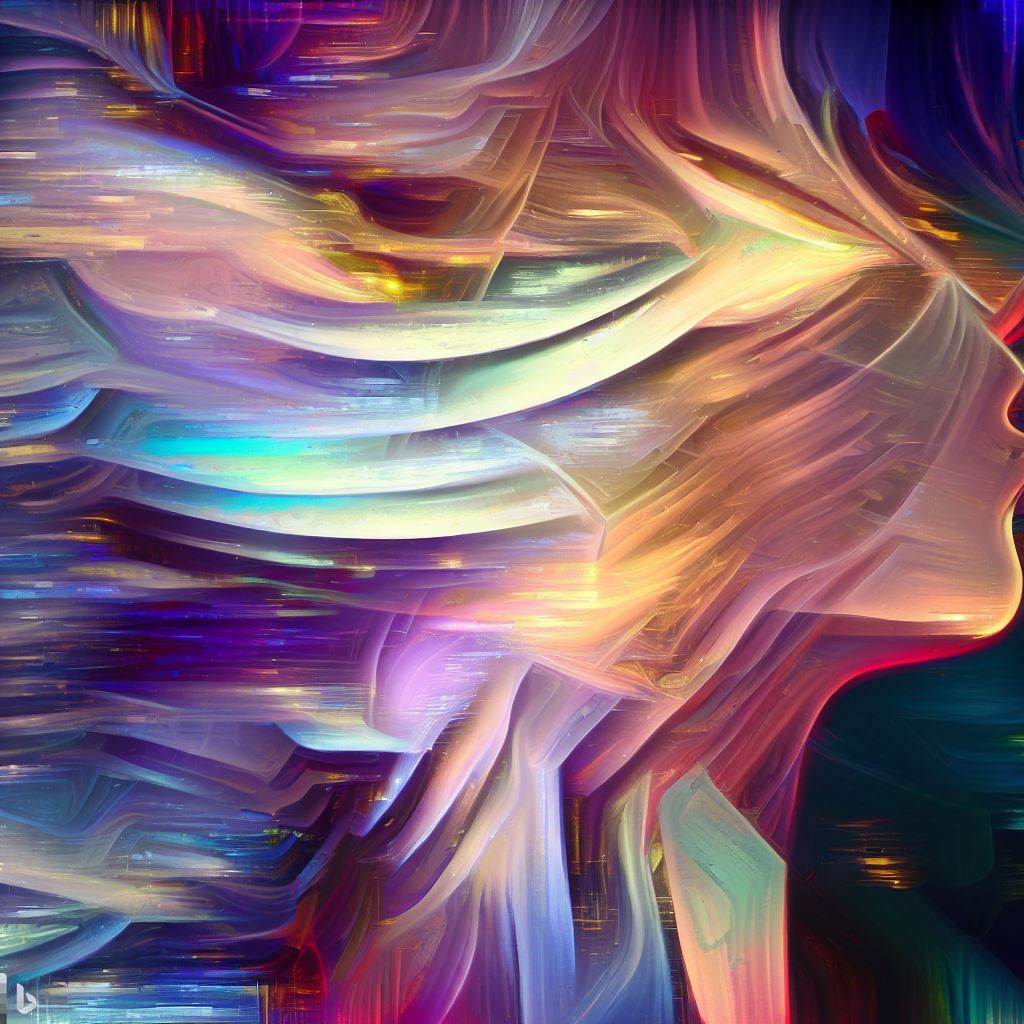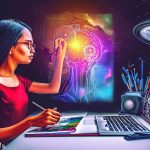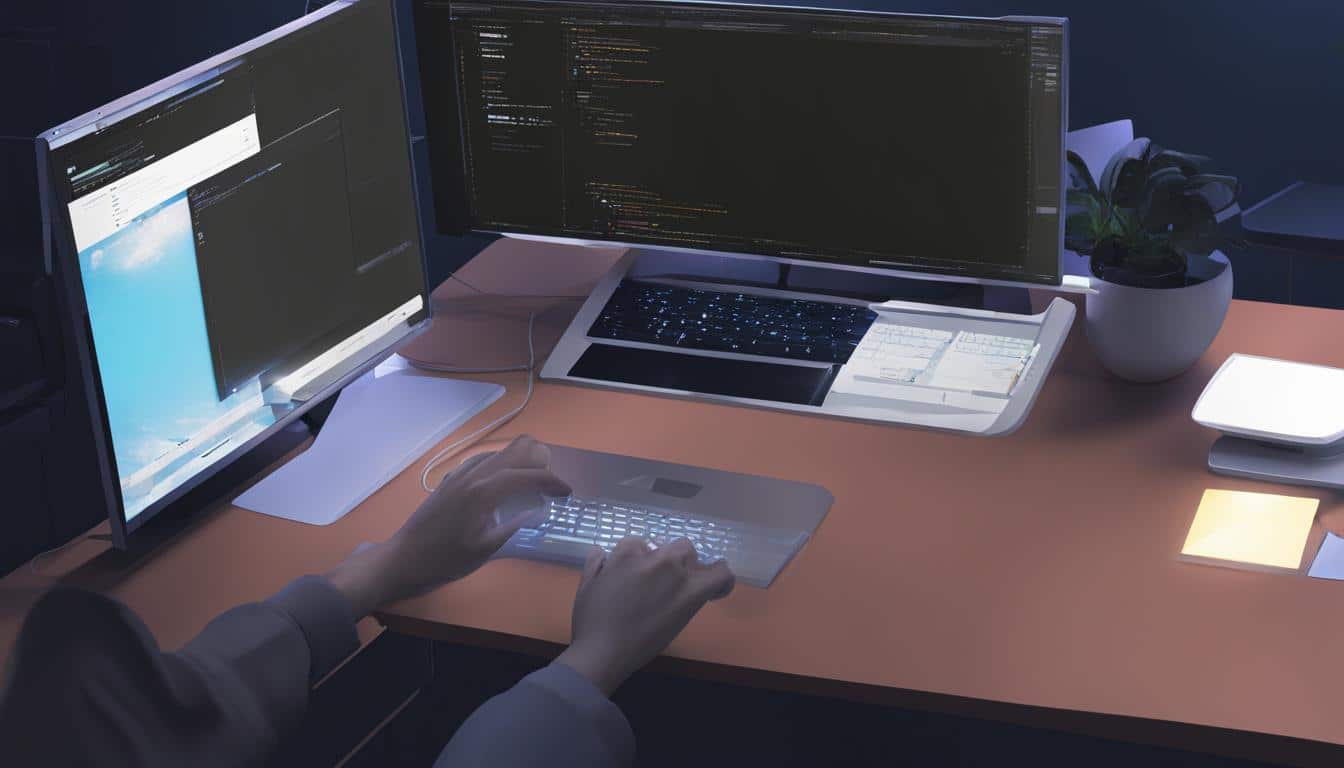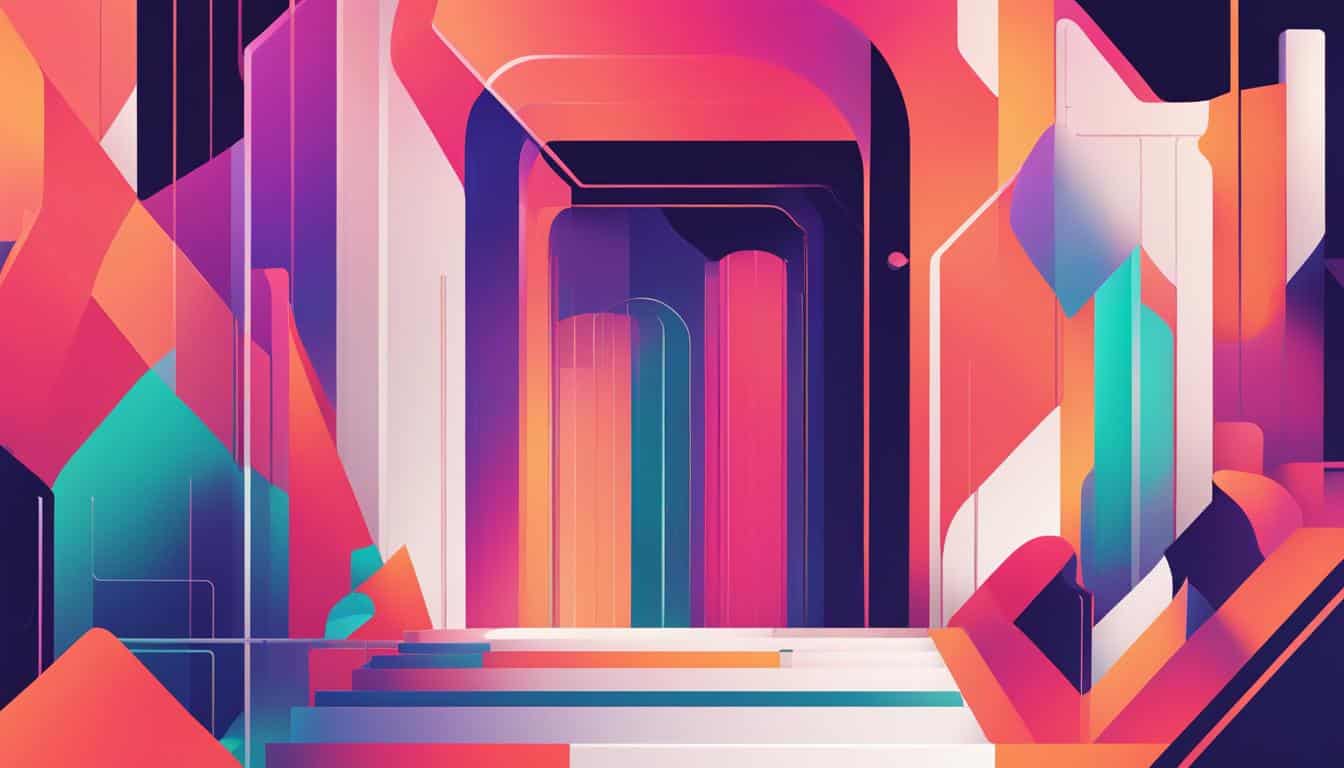Definition of Generative Art
Generative art is a form of art that relies on algorithms and computer programs to create unique, non-replicable pieces. It is created by mixing different variables, including randomness, user input, and predefined rules. The outcome is unpredictable and varies based on the algorithm used. Generative art has gained popularity due to its ability to produce beautiful designs that no one could have imagined.
Generative art can be produced using various tools or programming languages, such as Processing, Max/MSP/Jitter, openFrameworks, Pure Data/GEM, and Python. These tools allow artists to create complex dynamic visual systems to generate unique artwork continually.
The uniqueness of each generated artwork makes generative art a highly sought-after form of creation. Artists and designers of all levels are finding it easy to combine their technical skills with artistic creativity while creating generative art masterpieces.
Whether for digital paintings, installations in galleries or used in media such as videos or GIFs online – generative artworks bring new aesthetics and experiences around the world.
In 2014 artist Rafael Lozano-Hemmer created ‘Pulse Room,’ an installation featuring 100 incandescent bulbs suspended from the ceiling by long cables. Each bulb represented the heartbeat of previous visitors making this piece reactive but also representing individual connections between people through space-time. This installed artwork became an excellent example of how artists could engage and interact with their audience through generative art techniques.
Get ready to be mesmerized by these mind-bending examples of generative art – where math meets creativity to produce stunning visual masterpieces.
Examples of Generative Art
In the world of computer-generated art, there are numerous examples of algorithmically created masterpieces. These artworks are collectively termed as ‘Instances of Creative Coding‘. They are created by using various programming languages and techniques, which produces a variety of outcomes and results.
Here are the top 4 examples of generative art:
- Fractals: These are intricate patterns that are created using mathematical calculations. They have a self-similar quality, meaning every detail is a smaller version of the whole.
- Data-driven art: This type of generative art is created using real-time data inputs. For instance, by using weather data, this genre produces visually appealing displays such as real-time wind patterns and temperature maps.
- Randomness: Some generative art uses randomised processes to create unpredictable and surprising visual outcomes. The outcomes of these art pieces are impossible to predict, creating a unique experience every time.
- Interactive art: This is produced when artists allow users to interact with their creations in some way, allowing them to guide the outcomes and produce something unique and personalised.
Generative art is known for its limitless potential, and therefore, it is difficult to define its boundaries. However, one of its unique attributes is that it can continue to evolve on its own, producing new and interesting outcomes.
If you are an aspiring artist or programmer, the possibilities of creating algorithms for generative art are endless. It’s exciting to think about the potential of generative art and how it can affect our world. With endless potential, it’s a playground for endless experimentation and creative inspiration.
Who needs artists when a computer can create masterpieces on its own? Welcome to the amazing world of computer-based generative art.
Computer-Based Generative Art
Generating images, sounds, or animations using algorithms and mathematical calculations is known as The Art of Algorithmic Generation. It involves harnessing the power of computers to create art that reflects the artistic vision of the programmer. Computer-Based Generative Art has come a long way since its inception in the 1960s, and today it offers endless possibilities for creating unique pieces that push the boundaries of what we consider art.
- One of the primary characteristics of Computer-Based Generative Art is randomness
- The Generative process used by computers enables patterns to form spontaneously.
- Another exciting aspect of this type of art is its ability to create countless variations on a theme, rendering each piece unique.
- Non-repetitive output being one such example makes generative art distinct from traditional handcrafted artworks.
The interesting fact about Computer-Based Generative Art is that it can be both static and dynamic; it can exist as images or animations that are constantly changing in response to conditions set forth by algorithms. This process ensures that no two artworks are precisely alike, and one may never produce precisely the same results twice.
In recent years, there has been an increasing awareness and appreciation for generative art among art enthusiasts around the globe. There have been several exhibitions dedicated to showcasing this type of artwork where people can witness firsthand how computers can elevate artistic expression above and beyond what was imaginable before.
Just because it wasn’t created on a computer doesn’t mean it wasn’t generated through some sort of artistic wizardry.
Non-Computer-Based Generative Art
Traditional Generative Art Techniques
Traditional generative art techniques, including non-computer-based methods, involve using random or predetermined systems to create and determine the outcome of an artwork. These methods often include chance operations, such as the roll of a dice or shuffling cards, to arrive at a final product. Some traditional techniques may include ink blots, staining techniques, collage cut-outs and frottage.
In furtherance of traditional techniques, another method is called the ‘kite technique’, which was introduced by Henri Matisse. This technique involved him cutting shapes out of colored paper and arranging them on the ground until he found the desired composition before sticking them onto his painting surface.
Interestingly, Pablo Picasso also employs collage cut-out in his work.
Source: MoMA Learning Online Course
Get ready to witness the magic behind the art with these mind-blowing techniques used in generative art.
Techniques Used in Generative Art
Techniques Used in Generative Art:
Generative art involves using computer algorithms to generate artwork that is unique and constantly evolving, creating an experience for the viewer that is never the same twice. The techniques used in generative art can vary widely, but are essential in creating compelling and interesting pieces.
The following table showcases some of the most common techniques used in generative art, with corresponding examples:
| Technique | Example |
|---|---|
| Fractal Generation | Mandelbrot Set |
| Cellular Automata | Conway’s Game of Life |
| Genetic Algorithms | Evolutionary Art |
| Noise Generation | Perlin Noise |
| L-systems | Plant Fractals |
Each of these techniques comes with its own set of rules and parameters, allowing artists to experiment and create unique works based on their inputs and creative vision.
One unique detail of generative art is the fact that the resulting artwork is often not deterministic – meaning that even given the same parameters, the output can differ each time it is generated. This creates a sense of randomness and unpredictability, making every viewing experience unique.
Pro Tip: When creating generative art, it’s important to experiment with different techniques and parameters to find what works best for your desired aesthetic. Don’t be afraid to try new things and push the boundaries of what’s possible in this exciting and constantly evolving field.
Randomization is like a box of chocolates, you never know what kind of art you’re gonna get.
Randomization
One of the techniques utilised in creating generative art is the process of stochasticity. This refers to the use of randomization in generating patterns, shapes and colours. By randomly altering parameters, complex and unpredictable forms can emerge, leading to unique pieces of artwork.
A Table can help showcase how randomization is incorporated in creating generative art:
| Randomization | Description |
|---|---|
| Parameter manipulation | Modifying variables such as size, position and colour produces unique outputs |
| Noise functions | Calculating small variations in gradients or patterns lead to unpredictability |
| Algorithmic generation | Using mathematical formulas to generate art without predetermined outcome |
It is important to note that there are various approaches towards implementing randomness in generative art. Some artists may choose to incorporate human input or utilise pre-existing data sets to manipulate parameters.
In contemporary art movements such as computer-based art, stochastic processes have become an essential part of artistic expression. Randomness has been explored throughout history in various art forms such as Dadaism, Surrealism and Abstract Expressionism.
Generative Art highlights how technology has allowed for new ways of exploring creativity through stochastic processes like randomisation. Each piece produced is a unique creation born from the application of coded algorithms and chance operations.
Who needs creativity when you have algorithms to do the heavy lifting? Welcome to the age of procedure-based art.
Algorithmic/Procedure-Based Creation
The creative process of generative art involves using algorithms or procedures to generate imagery or music. It is known as Algorithmic/Procedure-Based Creation.
Here’s a 4-Step Guide to get you started:
- Define the problem and brainstorm ideas
- Determine the parameters and variables to be incorporated in the algorithm.
- Write the code, test, and refine it until the desired outcome is achieved.
- Apply aesthetics-oriented refinements and save a copy.
In Algorithmic/Procedure-Based Creation, randomness plays a significant role in generating unique results every time the code runs. Thus, each output can be viewed as an individual artwork.
Although computer-generated art has been around since the 1960s, its popularity skyrocketed in the 1990s with intervention by innovative software designers such as John Whitney. Inspired by his work on analog computers used for filmmaking, he created impressive visuals that showed his skills’ potential.
Interaction in generative art is like playing chess with a robot – you never know what moves it’s going to make, but you’re fascinated to see the outcome.
Interaction
One of the main aspects of generative art is its interactive nature. Users are often encouraged to engage with the artwork by manipulating certain parameters or inputs. This allows for a unique experience with each viewing or interaction, as the output will vary depending on the user’s actions. Through this interaction, both the user and the artwork become active participants in the creation process.
Interactive generative art can be created using various techniques such as algorithms, programming languages, sensors and controllers. These techniques allow for real-time feedback and manipulation of the artwork through user input. For example, an artist may use sensors to detect movement or sound, allowing for a piece to constantly evolve based on environmental stimuli.
Furthermore, artists may utilize machine learning techniques such as reinforcement learning to create artworks that learn and adapt over time based on user interactions. This allows for a deeper level of engagement and personalization between the viewer and artwork.
To enhance user engagement in interactive generative art, artists can incorporate intuitive interfaces that allow for ease of use and clear feedback. They can also provide clear instructions to guide users in their interactions with the piece.
In summary, interactivity is a crucial aspect of generative art which allows for a unique and dynamic experience with every interaction. Through techniques such as algorithms, sensors and machine learning, artists can create artworks that learn from and adapt to user input. By enhancing user engagement through intuitive interfaces and clear instructions, artists can encourage greater participation in their work.
Generative Art has come a long way from scribbles on an Etch-a-Sketch, but thankfully we’ve left those pesky knobs behind.
History and Evolution of Generative Art
Generative art has had a fascinating journey since its inception. It started as an experimental art form, but now it has become an integral part of contemporary art. The evolution of generative art has been a result of various technological advancements, including digital tools, computer programming, and algorithms, which have made it possible to generate art through code.
Generative art can be traced back to the 1960s when artists began exploring the concept of randomness and chance operations in their artwork. They used various techniques like flipping coins or throwing dice to make decisions in their work. However, with the advent of computers in the 1970s, generative art began to take on a new form. Artists began programming computers to generate art, which led to the emergence of digital art.
In the 1980s, with the rise of personal computers, artists were now able to make digital art more accessible. Artists like Vera Molnar and John Whitney began experimenting with coding to create algorithmic art. By the 1990s, generative art had become more sophisticated, and artists were using complex algorithms to create art that responded to the environments and input.
Recently, generative art has evolved into interactive installations, where viewers can actively participate in the creation of the artwork. Artists have experimented with various techniques like machine learning, virtual reality, and augmented reality to create immersive experiences for their audience.
To get started with generative art, learn to code and understand the basics of algorithmic art. Explore different techniques and experiment with different programming languages. Collaborate with artists and programmers to create unique generative art pieces.
Before computers, generative art was just called ‘making a mess with paint and hoping something cool happens’
.
Early Beginnings
The earliest roots of generative art can be traced back to the 1960s when computer technology began to emerge. In those early days, artists experimented with algorithms and random processes to generate abstract patterns and designs. One notable example is the work of Vera Molnar, who created geometric shapes using a plotter. This approach was later expanded upon by artists such as Michael Noll, who developed software to create intricate images based on mathematical formulas.
As generative art developed, artists began incorporating concepts from systems theory, cybernetics, and information theory into their work. They explored the idea of creating self-organizing systems that could produce complex output from simple rules or instructions. One such artist is John Whitney, who used analog computers to generate animated patterns and designs.
While early generative art focused primarily on abstract compositions, in recent years it has evolved to encompass a broader range of styles and mediums. Today’s generative artists use code and algorithms to create everything from music and animation to interactive installations and sculpture.
Pro Tip: To explore the possibilities of generative art for yourself, try experimenting with different programming languages or tools such as Processing or Max MSP. Keep an open mind and allow randomness and chance operations to guide your creative process.
In the 20th century, generative art went from scribbles on paper to scribbles on a computer screen – progress?
Development in the 20th Century
The 20th century saw a significant advancement in the development of Generative Art. This was an exciting time when computers and technology were becoming more accessible, leading to a growth in creativity. Artists started using computer programs to generate complex patterns and designs that were impossible to create by hand. The use of algorithms, code and mathematical models helped artists explore new art forms, resulting in the creation of innovative pieces never seen before.
With this rise in technological advancement, Generative Art soon found its place in various fields like design, architecture, music and multimedia. New tools made it easy to make different iterations of a single piece of art, leading to an entirely new form of interactive and immersive artworks.
Artists started paying attention to generative art’s potential for AI experiments. Computational systems could now produce pieces autonomously without any human intervention, enabling pure randomness governed by a set of rules. Many works emerging from this development captured dynamic flow patterns such as swarm behavior or biological simulation.
As we continue into the present day where more advanced AI technologies are being developed continuously; there is no doubt that generative art will keep evolving and changing rapidly. Generative Art has become a fascinating way for exploring Artificial Intelligence possibilities while blurring lines between Science and Art.
A rapidly growing field deserves our curiosity too; diving deeper into it may prove valuable even outside visual media creation due to its reflections on what machines can achieve beyond their typical roles. Discovering creations arising through algorithmic techniques leaves us with infinite possibilities in front of us – further exploration awaits!
If you thought your math teacher’s abstract doodles were impressive, wait till you see what contemporary generative art can do.
Contemporary Generative Art
The practice of creating contemporary generative art involves producing artwork that is created with the help of algorithms, computer programs or other systematic methods. These techniques enable artists to produce unique pieces with an ever-evolving design. Generative art has developed alongside technology and has expanded from simple geometric patterns into more complex and intricate pieces, including multimedia installations, virtual reality experiences, and interactive displays.
Contemporary generative art requires a balance between the artist’s creative input and the computer-generated algorithm. The growing use of Artificial Intelligence (AI) technology has enabled this process to become even more intuitive as it can learn from an artist’s style and translate this to a generative output.
Generative art also offers great potential for exploration as it encourages experimentation, data analysis, and mathematical manipulation in its creation. The possibilities are endless, with many artists using this medium as a way of expressing complex ideas or data visually.
One noteworthy feature of contemporary generative art is that it is often interactive, enabling viewers to participate in the creation process and explore the artwork on their own terms. This creates a unique experience for each individual viewer as they navigate through different elements that have been generated by the algorithm.
In 2017, media artist Joshua Davis created ‘IDNA’, a generative installation at the National Museum of Modern Art in Kyoto. The exhibition used algorithms influenced by his DNA samples to produce various patterns used in the installation. The show was a success and was lauded for its innovative approach to creating interactive installations using generative programming.
The evolution of generative art continues to evolve rapidly thanks to advancements in technology and growing interest among artists worldwide. It will be fascinating to see how this medium continues to develop over time as artists push boundaries further towards new horizons.
Generative Art: Because why settle for a single masterpiece when you can have endless possibilities?
Applications of Generative Art
Generative art is a modern form of art that involves an automated process for creating art using a set of predetermined rules or algorithms. It has many practical applications ranging from design to entertainment. Here is a breakdown of how generative art is used in different fields:
| Field | Applications |
| Design | Logo creation, website design, fashion design, package design |
| Education | Teaching geometry, biology, physics, and other subjects using interactive visual tools |
| Music | Creating new sounds and music using algorithms |
| Architecture | Building design using generative algorithms, construction planning, and energy management |
| Games and Entertainment | Video games, interactive art installations, virtual and augmented reality experiences |
Generative art enables artists to create unique and complex compositions that were impossible to achieve through traditional means. It also allows designers to automate tedious tasks, reducing time and costs. Moreover, it helps educators to create visually stimulating and interactive learning environments. Finally, generative art promotes creativity as it can inspire innovative problem-solving skills.
A study by the University of Cambridge found that exposure to generative art can improve one’s cognitive flexibility. Processing complex visuals in a fast-paced environment challenges our brain’s processing abilities, leading to improved decision-making and cognitive agility in various tasks.
Fine art: because who doesn’t love paying millions for a canvas with a dot on it?
Fine Art
Within the realm of visual creativity, creations that can be defined as an embodiment of human emotions and perceptions are considered phenomenal. These creations, which can be interpreted as aesthetic expressions of beauty and imagination, are widely known as ‘visual art.’
The following table illustrates the various forms of Visual Art that exist in contemporary society:
| Form | Definition | Example |
|---|---|---|
| Painting | An artwork composed with pigments on a surface such as paper or canvas. | The Mona Lisa by Leonardo Da Vinci. |
| Sculpture | A work created by shaping materials such as stone or steel into three dimensions. | The Thinker by Auguste Rodin. |
| Mixed Media | An artwork made using a combination of media such as painting, collage, photography, etc. | Jean-Michel Basquiat’s Untitled (1982), which incorporates painting and drawing on paper mounted on canvas. |
In recent years, generative art has emerged as another artistic genre that employs algorithms and mathematical equations to produce images and designs. It combines traditional techniques with modern computational processes allowing artists to create art that is virtually infinite in its scope.
Generative art enables us to reproduce previously non-existent artworks at an unparalleled rate and magnitude. Artists who leverage this technique often push the boundaries of creativity to explore new frontiers unachievable through traditional means. It provokes curiosity among patrons interested in exploring novel modes of artistic expression.
Do not miss out on experiencing the imaginative and infinite world of generative art where boundaries do not exist. Explore and witness some of the most fantastic creations by contemporary artists that showcase the potential of generative art. Designing with generative art is like having a collaboration between a computer and your artistic alter-ego, resulting in designs you never knew you even wanted.
Design
- Designers use code to develop complex shapes and forms, which would be impossible through traditional design methods.
- It allows for variations or mutations in design patterns, making each piece distinct and one-of-a-kind.
- Generative design can be used in product development, such as creating prototypes for furniture or automotive parts.
- The synergy between generative art and design provides an opportunity for artists to experiment with abstract concepts that go beyond the scope of conventional art-making techniques.
- Design-driven generative art can help architects integrate new insights into their work, allowing them to optimize visual results while striving for sustainable solutions.
Aside from its practical application in various industries, it is worth noting that the integration of generative art into commercial works is gaining momentum. The remarkable flexibility of this form allows designers not only to achieve a unique look but also to produce something entirely unexpected.
A report published by Grand View Research revealed that the global market for generative software would grow at a CAGR of 17.6% from 2020 to 2027. The growing demand for advanced computational technology and artwork optimization strategies will drive demand growth over the forecast period.
Trying to understand the human brain through neuroscience is like trying to navigate a maze with a blindfold on – you’ll probably just end up hitting a wall.
Psychology and Neuroscience
The intersection of the arts and science leads us to new insights into how the human mind works – unlocked through psychedelic art, therapeutic techniques, synesthetic experiences and altered states of consciousness.
Eye-catching generative art serves as a powerful tool for examination and illustration of cognitive processes like perception, emotion, and creativity. These dynamic visuals have given researchers unparalleled access to both subjective and objective perspectives of our internal landscape.
The future of generative art is as unpredictable as a computer-generated fractal pattern, but one thing’s for sure – it’ll never run out of creative possibilities.
Future of Generative Art
Generative art is shaping the future of digital art. The endless possibilities of technology and AI are providing an opportunity to create unique and interactive artworks. From producing intricate music to designing complex visual patterns, generative art is becoming popular among artists and art enthusiasts alike. The future of this art form is promising as it continues to evolve rapidly, driven by advancements in machine learning and data visualization techniques. The emergence of generative art has opened up a new realm of artistic expression that is not confined to traditional mediums.
The growing interest in generative art has led to an increase in the number of artists exploring this form. It has also provided a platform for non-artists to appreciate and engage with the art form. The future of generative art lies in its ability to merge the physical and digital worlds, creating art that interacts with its surroundings and the viewer. The use of generative algorithms will continue to evolve, leading to artworks that are dynamic and unpredictable. These developments will enable artists to produce artworks that are not only visually stunning but also hold deeper meanings and emotional connections.
The integration of generative AI in various industries provides new opportunities for artists to experiment with this art form. The growing demand for personalized and interactive experiences in the entertainment and gaming industries is a potential avenue for the future of generative art. The use of generative art in these industries could lead to a more immersive and engaging experience for the audience. This provides new opportunities for artists to showcase their work and build their reputation.
The future of generative art is exciting and full of possibilities. With advancements in technology and a growing interest among artists and enthusiasts, this art form is becoming increasingly popular. The fear of missing out on this emerging art form is real, and individuals who do not engage with it may miss out on something truly revolutionary. It is essential to keep up with the latest trends and developments in generative art to fully appreciate its potential and impact.
Technology has come a long way, from dial-up internet to generative art – who needs human creativity when you have computers?
Advancements in Technology
Emerging Technologies’ Impact on Generative Art
The constant evolution of technologies has greatly influenced the development and growth of Generative Art. With the advent of new tools, techniques and algorithms, generative artists have access to a vast array of options to create visually appealing pieces.
Incorporating Artificial Intelligence (AI) and Machine Learning (ML), artists are now able to create intricate patterns and designs that were previously impossible. Using AI algorithms, it has become easier to simulate complex natural phenomena such as cloud formations, fireflies, etc. ML is used in creating models that generate music based on the user’s preferences.
Advancements in technology have also brought changes to how artists can distribute their work. Blockchain technology allows users to purchase artwork using cryptocurrency while ensuring authenticity. Virtual Reality (VR) provides a platform where people can view art from home.
Creating an effective workflow for generative art involves investing time into mastering techniques and exploring various software solutions. Collaborating with other professionals in the field can also help generate fresh ideas.
To maintain a successful career in this field, it is important for generative artists to stay updated with emerging technologies and trends. Keeping an open mind and being open to experimentation will allow them to explore limitless possibilities in their work.
Looks like generative art is finally getting the recognition it deserves, no longer just something reserved for computer science grad students and Burning Man attendees.
Integration in Various Industries
With the rise of generative art, its potential applications across different sectors have become increasingly important. Here’s how this dynamic field can be integrated into diverse industries:
| Examples | |
|---|---|
| Advertising | AI-generated visuals for campaigns |
| Architecture | Parametric design and digital fabrication |
| Fashion | Automated patterns and custom clothing |
| Gaming | Procedural generation of game assets |
| Music | Algorithmic composition and live visuals |
In addition to these examples, generative art can also enhance education, healthcare, finance, and more. Its flexibility and versatility make it a valuable tool for innovation and creativity in the 21st century.
By exploring the intersection of art, science, technology and business, we can unlock new opportunities to solve complex problems and engage audiences in meaningful ways. Whether you’re an artist or an entrepreneur, incorporating generative art into your work can help you stay ahead in today’s fast-paced world.
Don’t miss out on the potential benefits that generative art has to offer. Start exploring its possibilities today!
Artificially created beauty might render human creativity and ingenuity obsolete, leaving us with nothing but a generation of lazy admirers.
Potential Impact on Society and Culture
As generative art becomes more prevalent, its potential impact on society and culture is immense. It has the ability to transcend traditional art forms and create unique experiences for viewers. In addition, it challenges our understanding of authorship and creativity in the digital age.
Generative art can also play a role in promoting inclusivity and diversity by providing a platform for underrepresented artists to showcase their work. Moreover, it has the potential to revolutionize industries such as design, advertising, and entertainment by enabling more personalized and authentic content creation.
Additionally, generative art presents opportunities for immersive installations that merge technology with physical spaces, creating a new form of interactive experience. As this technology advances, it is important to consider ethical implications related to data privacy and ownership.
To fully capitalize on the potential of generative art, we suggest investing in education and resources to support emerging artists experimenting with these techniques. Furthermore, embracing interdisciplinary collaboration between artists and technologists can lead to groundbreaking innovations within the field. By leveraging generative art’s ability to inspire emotion and challenge societal norms, we have the opportunity to shape the future of artistic expression in exciting ways.
Frequently Asked Questions: What is Generative Art?
1. What is generative art?
Generative art is the creation of artwork using algorithms, programming, and other forms of technology. It involves using software tools to generate or produce images and other forms of artwork that are unique and sometimes unpredictable.
2. Who is a generative artist?
A generative artist is someone who creates generative artwork using algorithms, programming, and other forms of technology. They use software tools and design techniques to produce images and other forms of artwork that are unique and sometimes unpredictable.
3. What role does artificial intelligence (AI) play in generative art?
Artificial intelligence (AI) is an important part of generative art. It enables the creation of AI art, which is artwork that is generated using machine learning algorithms. AI helps generative artists to develop new art and design tools and create artwork that is more sophisticated and complex.
4. How do you create generative art?
To create generative art, you need to use software tools, programming languages, and other forms of technology. There are many different approaches and techniques that you can use, including algorithmic and procedural art. The process of making generative art involves writing code and using software to generate images and other forms of artwork.
5. Who were some of the pioneers in the history of generative art?
Vera Molnár and Sol Lewitt were two of the most important pioneers in the history of generative art. They were both generative artists who used algorithms and other forms of technology to create their artwork. Michael Hansmeyer is another notable figure in generative art who is known for creating autonomous architectural structures using algorithmic design methods.
6. What are some examples of generative art?
Some examples of generative art include geometric patterns, abstract compositions, and dynamic animations that
Frequently Asked Questions
Q: What is generative art?
A: Generative art refers to any form of art produced using a system or a set of rules, often with the help of a computer algorithm, that generates some degree of autonomy or randomness in the creation process.
Q: How is generative art different from traditional art?
A: Generative art is different from traditional art in the sense that traditional art usually involves the direct expression of the artist’s vision, whereas generative art creates an environment in which the work is created through collaboration between the artist and the algorithm or ruleset.
Q: What are some common techniques used in generative art?
A: Some common techniques used in generative art include fractal systems, cellular automata, genetic algorithms, and markov processes.
Q: How is generative art used in practical applications?
A: Generative art is used in a wide range of practical applications, such as creating unique marketing materials, designing interactive installations, or even generating music and soundscapes.
Q: Who are some famous artists known for their use of generative art?
A: Some famous artists who have made significant contributions to the field of generative art include Vera Molnar, Akiyoshi Kitaoka, and Casey Reas.





